Victoria’s most westerly lighthouse has been guiding ships towards Melbourne since 1884, though it took 25 years to raise the funds to have it built on the coast near Portland.
My experience at the lighthouse
The Cape Nelson Lighthouse tour guide Gordon must have been cursing when he had our confirmation that we wanted to go ahead with our tour on a bitterly cold, wet and windy Sunday. By the time we reached the top of the spiral staircase and opened the door out to the balcony, Gordon reckoned the winds were close to 125kms/hour.

He advised me to take off my glasses if I was going to venture out onto the walkway, as the wind might be strong enough to blow them right off if I didn’t. That warning – and the sheer power of the gale blowing when we stepped out – was enough to put me off trying to walk the full circuit of the balcony. Gordon did it, though he went backwards to keep his balance, and the smile on his face when he made it round was enough to wash away any fears that we had disturbed him from a quiet Sunday afternoon by the fire.

This was by far the wildest day we had had for any lighthouse visit yet on this Vintage Victoria tour. The driving rain when we parked up by the entrance to the lighthouse grounds made us scuttle quickly up the path to the café and dry off with a cuppa and piece of cake before the start of our tour (Excellent café, by the way, and home-made cakes which made us wish they had still been open when we returned about an hour later).
Gordon turned up just before 2pm, protected by a full length DrizaBone, his notes and files tucked up under his armpit before he spread things out on the table to begin his talk in the warmth of the café.
Gordon, by the way, was brought up in Portland, and told us of childhood bike rides out from town to visit his friend who lived at the lighthouse – no easy thing, he said, due to the poor condition of the roads until way past his childhood years.
The café is housed in a beautiful bluestone building, which used to be a store room and home to the generators that kept the whole complex alive. Gordon pointed out the markings on the floor where the generators used to stand, now right by the counter with the cakes on it!
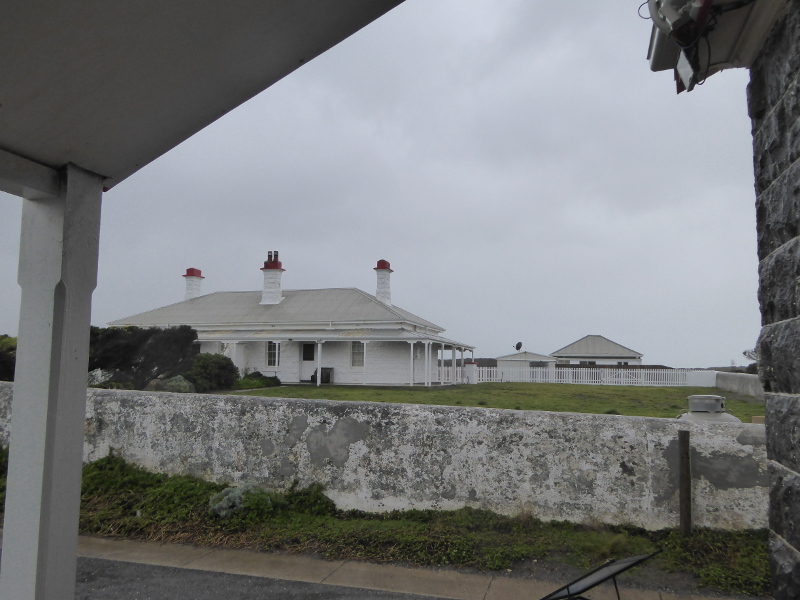
Across the way from this building is the staff accommodation, now available for fairly up-market stays. Right by the café is the double residence, two semi-detached homes, which housed the assistants and their families. The lawned area now would presumably once have been all vegetables and maybe the odd sheep or goat.
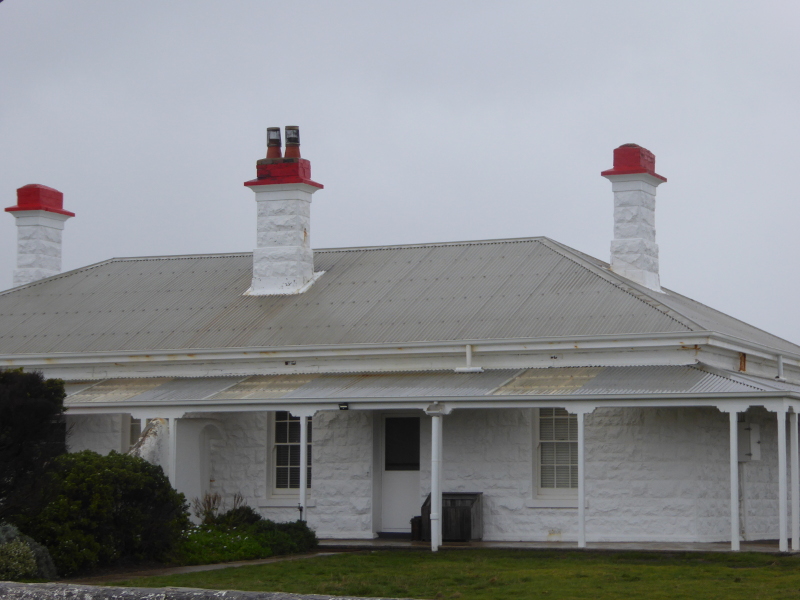
Further back is the larger house, home in the past for the senior lighthouse keeper. We didn’t get a chance to take a closer look, partly because it too is for overnight rentals, but also due to the terrible pouring rain that drove us straight to the lighthouse and then later back to our car to escape.
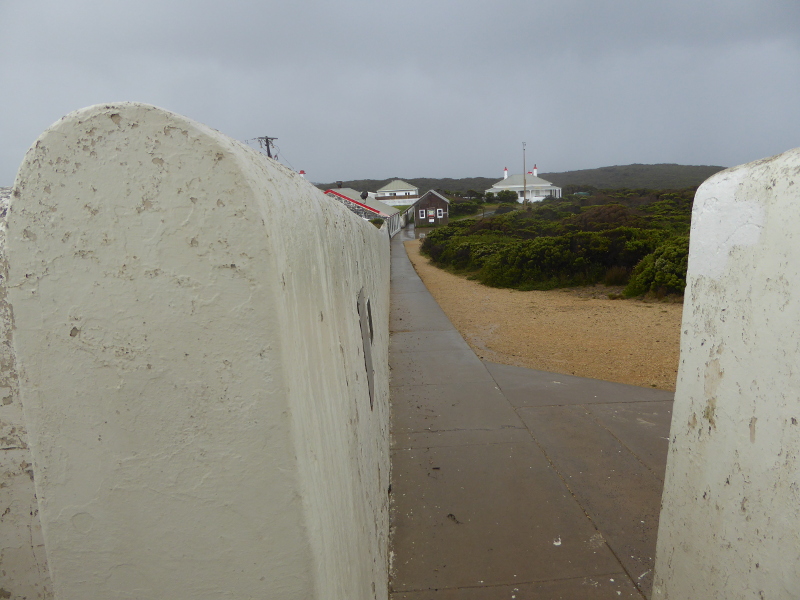
From the café building is a long path leading uphill towards the lighthouse, and beyond that a smaller, wooden hut, which we were led to first.
By the way, the tall white wall on our right as we walked up that path proved essential for us to keep our feet in the relentless gale that was blowing by then. You can see how useful that must have been for working keepers trying to get to the light in an even stronger storm.
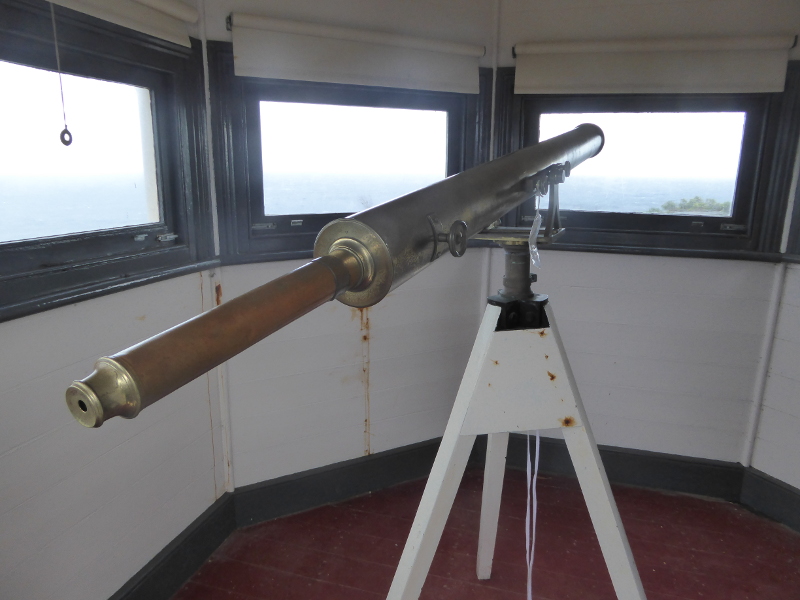
Inside the hut at the end of the path was this magnificent telescope, used for lookouts in years gone by. There is also a full set of signalling flags still tidily packed away in order on the shelves, with a handy reminder of what each flag is for on the wall.
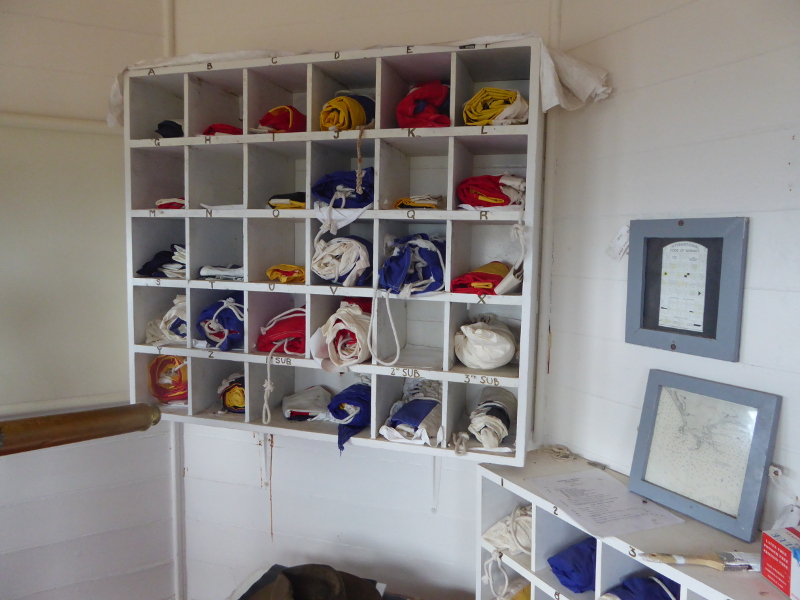
I asked Gordon if the sea we could see from here was just like any other day or whether the gale had blown up a bit of a swell. He said the waves were breaking a little but they could be choppier, and the swell, while pretty high at about 3m, was not as bad as it has been known to reach: he mentioned 8m swell, though that really is hard to picture.
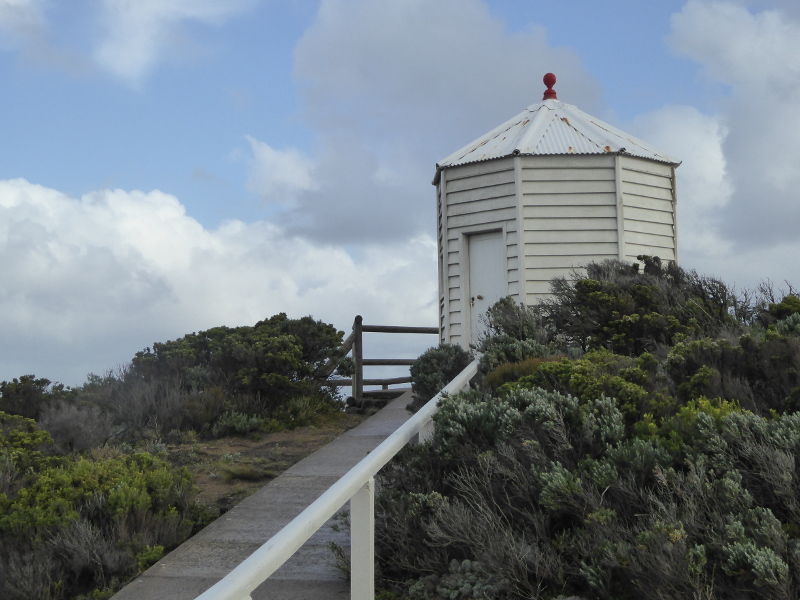
From the signal hut we walked back to the lighthouse itself.
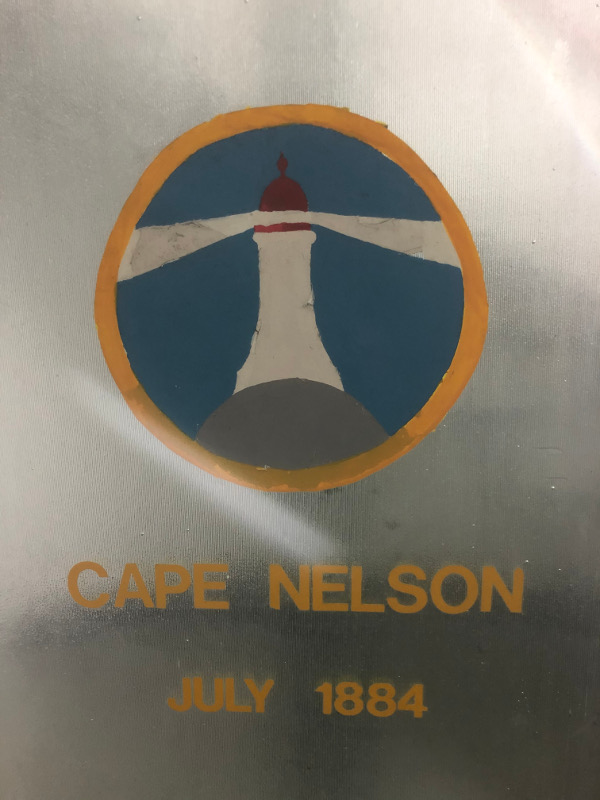
Inside, as soon as you walk in, there is this stained glass window commemorating the year the Cape Nelson Lighthouse finally opened, after so many years of campaigning, fund-raising and building.
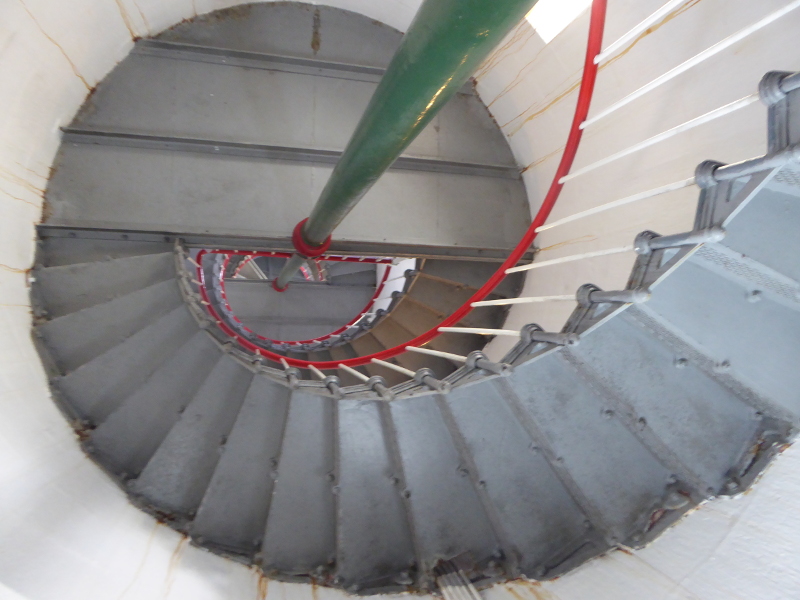
And then there is the spiral staircase, all 124 metal steps of it making as usual one of my favourite lighthouse photos.
As we climbed higher the steps and landings at each level began to get wetter, with puddles forming in some parts. “A leaking roof,” I was told, though nobody has yet discovered the source.
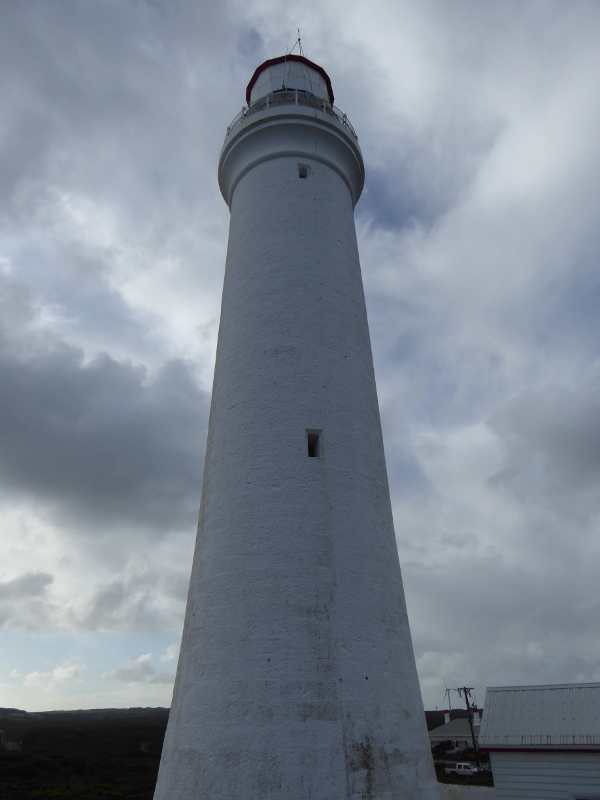
What did strike me, once we were up at the top level and right next to the light itself, was the movement I felt, prompting me to ask Gordon if I was imagining things, or was the lighthouse actually swaying?
“No,” he said, “that’s just the changing pressure of the air as it swoops down the staircase and gets sucked back up. It gives you the impression the building is moving.” So that was how windy it was up there that day.
If technical details of how lights work or how lighthouses get built are your thing, Gordon is definitely your man. Much of that went over my head really, but I did like the story of how a crane was brought inside the tower to help build and instal the staircase in the first place.
And I have absolutely nothing negative to say about Gordon. I was so bowled over by the drama of the weather and the experience, I didn’t really have head space for my usual social history questions about lifestyle of keepers or tales of rescues.
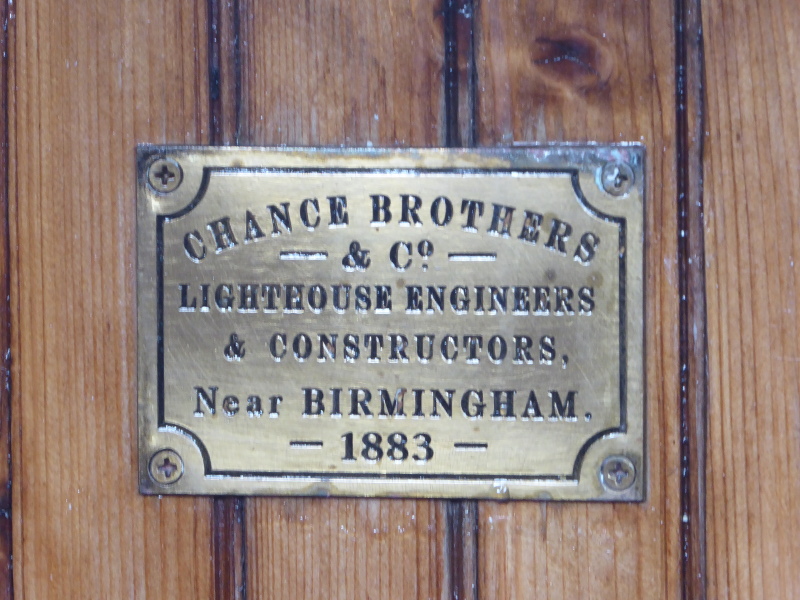
There was the usual Chance Brothers of Birmingham plaque.
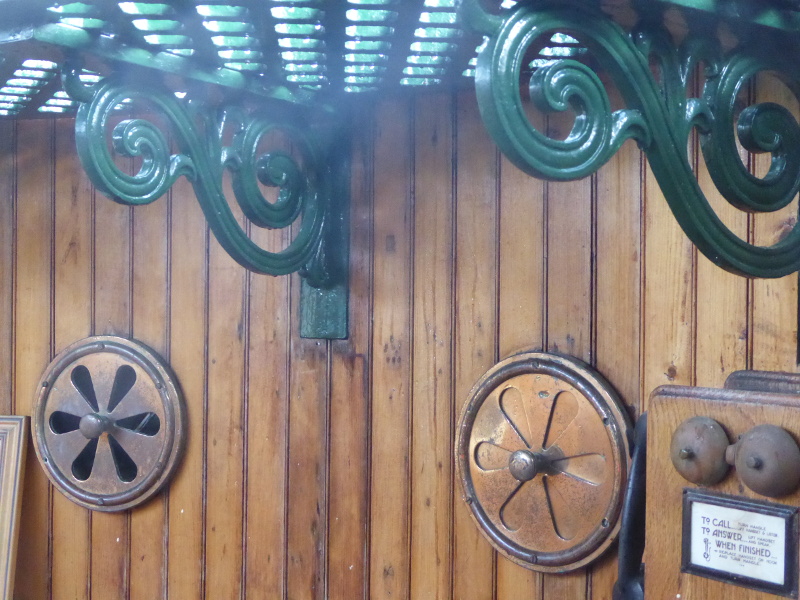
Lots of beautiful ironwork as always in these vintage lighthouses.
And then the walk out onto that balcony, with winds so strong it was pointless to wear a hat – even a beanie – and dangerous to wear those glasses.
I snuck out briefly to take a couple of shots, but the wind was too powerful for me to linger and take in the views, even as Gordon made his backwards turn himself.
Looking back up once we were back down and once more outside, I could see how the driving weather takes its toll on the ironwork (traces of rust) and the paintwork. It must be an extraordinarily expensive place to maintain, even the outer walls and ironwork.
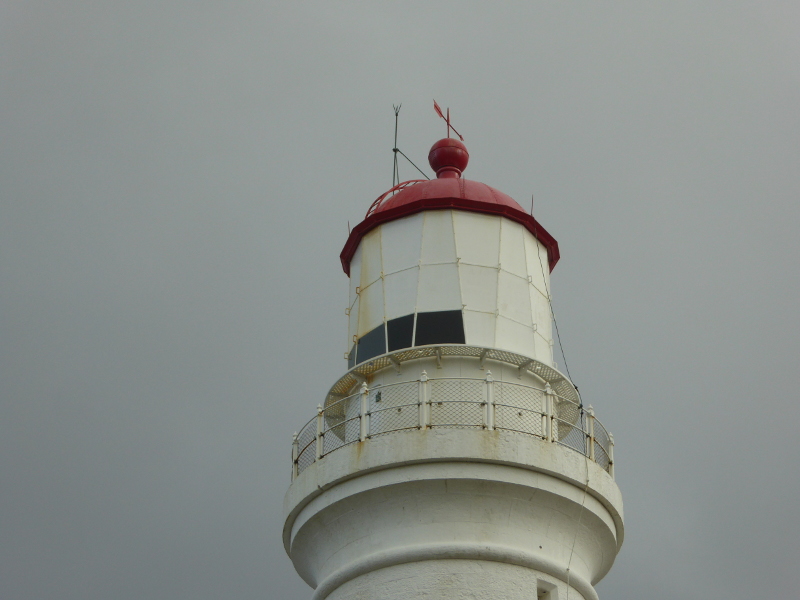
I mentioned to Gordon that we have signed up for a website that lets you know if a lighthouse comes up for sale in the UK, as we have a dream of one day getting away from it all and living somewhere remote off the north coast of Scotland, but Gordon’s estimate that paintwork alone might be in the region of $100,000 a year has rather made me think again about that pipedream…
What a fantastic place Cape Nelson Lighthouse is, though. No photos here give any sense of the power of that wind. But no wonder they wanted a lighthouse built here, as it gave ship masters more options for arriving safely in Australia after long journeys from Europe or America.
We’ll have to come back some day to stay in the accommodation, and let ourselves dream of how things must have been to live here, and of course to see the light when it is operating after dark. Must be quite a sight for sore eyes, whether on land or at sea.
Practicalities
There are lighthouse tours every day at 11am and 2pm, but you do need to book in advance, especially on quiet winter’s days. There is a link to the contact details, and the tours cost $15, including the precinct as well as the lighthouse itself.
The cafe serves up some excellent-looking cakes but closes just as the last tour leaves.
Toilets in the cafe building.
The lighthouse stands right on the walking trail which continues along the cliff-tops towards Cape Bridgewater.

History and stories
Cape Nelson Lighthouse was being talked about as early as 1859 after a series of shipwrecks not far from here.
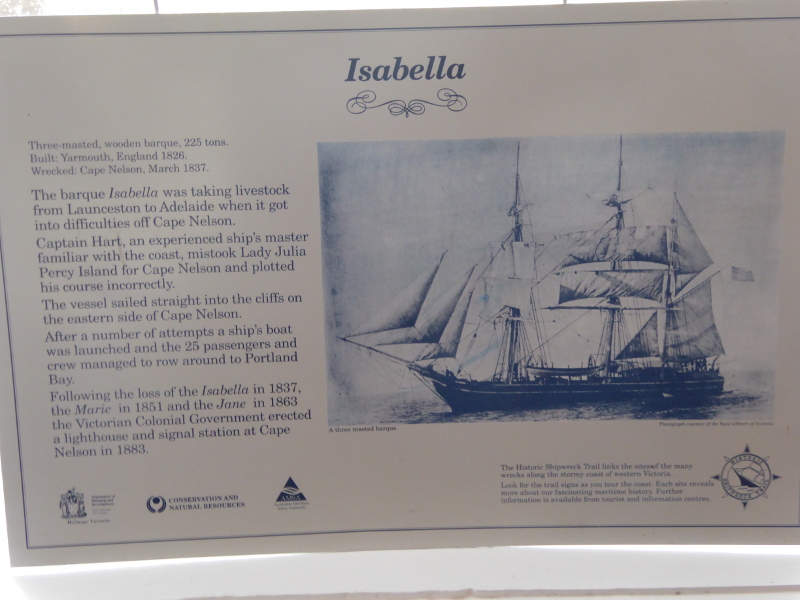
By December 1881, authorities still hadn’t made funds available for it to be built.
In March 1882 the specifications for the new buildings were finally published, and I rather liked the reaction of the Portland Guardian, which thought the storeroom, workshop and cart shed resembled more the kind of building you’d expect for a ‘fanciful duke’ than a mere government shed. The correspondent also lamented the ‘verbosity’ of the tender’s language, making it hard even for a professional like him to understand.
An October 1882 report of a walk from the town to the lighthouse building site spoke of good roads for the first mile or two, but then the surface turning sandy, which is exactly the memory of our lighthouse guard Gordon who remembers cycling on that route in the 1960s, so the tarmacked road is a relatively new thing here.
The foundation stone was laid in 1883, with a copy of two newspapers – the Mirror and Guardian – and seven ‘coins of the realm’ placed in the cavity.
When the lighthouse finally opened in July 1884, a Mr Fish was the first keeper, transferred from Gabo Island, right along the coast near Mallacoota. The local paper reckoned he and his family would find the Cape ‘much pleasanter’ than the Island posting…He was still there two years later, when there was an intriguing warning in the local paper that he planned a practice of the new rescue rocket equipment and people near the lighthouse should beware!
The Hamilton Spectator correspondent, who attended the opening ceremony on 7 July 1884, noted that the ‘cork-screw’ staircase could be walked up by a lady as easily as she might ‘an ordinary staircase at home’.
In December 1884, drama came not from the sea but the land near the lighthouse. One of the keepers, a Scotsman called Thomas McBain, was attacked by four cows which knocked him down and then prodded his leg with their horns. He only escaped by jotting a note onto paper and attaching it to a dog’s collar, sending the dog back to a neighbouring farm from which help eventually came. The injured leg never recovered enough for him to climb the Cape Nelson stairs and he was transferred soon after to a lighthouse with less climbing to do!
And the biggest event to hit the lighthouse in its first ten years or so was when a black snake coiled itself around both legs of the duty keeper one night in April 1895. The keeper was not bitten but he suffered from shock after he had killed it, and he was somewhat relieved to find that it had lost one of its teeth!
The life of a lighthouse keeper was not all about keeping an eye out for ships in distress. Sometimes it was sheep rather than ships. In 1901, two sheep had to be rescued off a rocky ledge 50m above the crashing sea, when they slipped off the cliff when nibbling the grass too close to the edge. The keeper had himself lowered by rope and brought the sheep back up to safety one by one. Two years later one of the lighthouse keepers’ cows fell over the same cliff, but didn’t survive the drop.
There were few major shipping incidents near the lighthouse in the years after it was built – showing presumably just how useful it was – but a story from 1912 struck me. A sailing boat took 52 days to get from Hobart to the Victorian coast near Cape Nelson, on its way to Adelaide. The slow journey was apparently due to strong gales blowing in the wrong direction, but that is such a slow crossing, it’s almost unbelievable. But then, running low on supplies, the captain’s wife fell sick, and they signalled the need for a doctor to the Cape Nelson Lighthouse. The keeper responded and helped a Portland GP to get out to the boat to tend to the sick lady. What an ordeal. So, shipping incidents didn’t always need to be wrecks on rocks.
The first motor car trip to the lighthouse was made on Saturday 7 August 1920, after lighthouse staff worked to make the road surface usable by motor vehicles. They were quoted in the Portland Guardian as ‘hoping other car owners will make the trip’ in future…
Five years later, when a young lady from Sydney drove through the area and paid a visit to the lighthouse, her comments on the state of the roads made the news too: “Why,” asked Miss Babs Hart, “is there not a motor track to the Cape Nelson Lighthouse – one of Australia’s finest views?” I couldn’t help wondering, though, if Miss Hart’s comparison of Portland’s beach to the Lido at Venice was not more to do with her name-dropping places she had seen than a genuine comparison…
A visitor in 1931 also moaned about the inaccessibility of the lighthouse from Portland. He complained that all the overhanging branches and twigs scratched the paintwork of his car. But he was also one of the few visitors to speak of family life at the lighthouse complex. Frank Piper was a ten year old, who’d be 99 years of age if still alive today. He was doing well with his schooling by correspondence from Melbourne, though he had some difficulty reading due to the loss of one eye earlier in his life. But the tale of his first ever encounter with other children, after six years with his parents at even more isolated lighthouse postings, was moving indeed. Apparently young Frank burst into happy tears when he met his first fellow youngster aged 6.
There was a nice story from August 1945, when the keeper Mr Hamilton, had set off from the lighthouse to Portland on foot to get a haircut in town. By the time he arrived in town, news of the end of the War had come through and he arrived in a Portland jubilantly out in the streets celebrating.
The winter of 1948 saw exceptionally severe storms, one of which washed two brothers off the rocks not far from the lighthouse while they were fishing. A two and a half hour search involving ropes and lighthouse staff failed to find them. Another storm the same year blew away 50 feet of the lighthouse verandah, presumably meaning the metal walkway up at the top of the light – a scary thought, having been up there in a similar wind in 2020.
And the last real story to emerge from my Trove search concerned a message in a bottle picked up off the rocks near the lighthouse in 1949. Such messages were actually dropped off boats for scientific reasons – to study the flow of tides and currents – though they always conjure up romantic images of people shipwrecked and deserted on tropical islands, or school girls having a fanciful dream of marrying the person who picked up their message, for example. The discovery in 1949 made the news all over Australia, as it turned out the message had been drifting on the seas for 20 years, having been dropped off by an American vessel in 1929, with a note to return it to the Hydrographic Department in Washington DC. Quite a lot of water under the bridge since that captain cast the bottle into the sea.
What are your experiences at Cape Nelson Lighthouse?
Has anybody got any stories to bring us up-to-date with incidents that made the news from the 1950s to the present day?
Anybody seen a whale through that big telescope?
Or does anyone just have a good story about Cape Nelson Lighthouse that they’d like to share here?
Other links and writings on the Cape Nelson Lighthouse
This is the Lighthouses of Australia website entry on Cape Nelson Lighthouse.
A 2012 visitor was the Nomadic Explorer blogger.
This post from the Western District Families website has a good history of the Cape Nelson Lighthouse and has copied some of the old newspaper articles about the building.
This 2016 entry from the Weekend Walking blog spoke of a walk which ended at the light house café.
Another 2016 piece comes from photographer and artist Julie Powell.
Finally, I found this extraordinary horror story from 2015, nothing to do with shipwrecks or ghosts…

